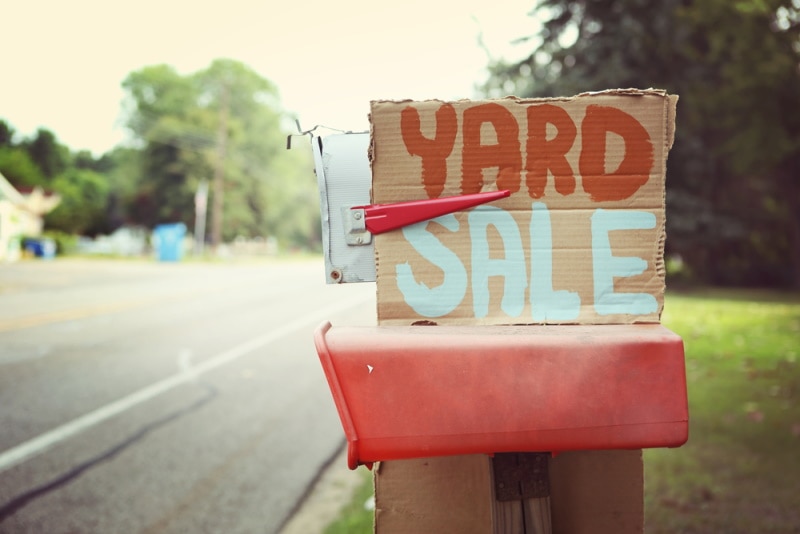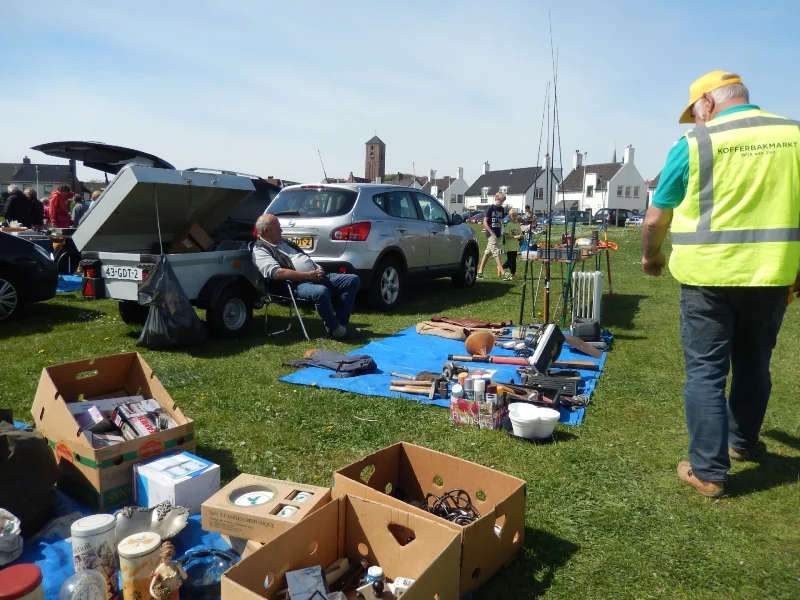Yard Sale Pricing Guide – How Much Is My Stuff Worth? (2025 Update)
-
Codee Chessher
- Last updated:

Yard and garage sales are some of the best ways to get rid of unwanted clutter around the house and make a few bucks in the bargain. If you’ve been to a few, you know that not all yard sales are created the same. To make sure your stuff sells, we have written a comprehensive guide on how to price and sell your yard sale items. Read below to delve into the details.

Before You Begin
Holding a yard sale seems easy, but there’s more to it than just chucking stuff outside and hoping someone buys it. As with anything, the five Ps apply here: proper planning prevents poor performance.
First things first, check your state’s laws on yard and garage sales. Most states require you to apply for a permit, but few require you to collect tax on items sold because there’s typically no net profit. Texas is a notable exception, requiring you to collect sales tax on all taxable items. It’s a pain, but you might have to get a permit before hosting a yard sale.
After you have a permit, you may wish to advertise your yard sale. Let your friends on social media know the date and location of the yard sale, post an ad on Craigslist, or even just put a sign up at the nearest intersections. You’d be amazed what a smidge of marketing can do.
Next, you’ll need to set up your yard. You’ll need tables to display items at a bare minimum—those plastic folding ones are perfect for this. The other essential items are a Sharpie and sticky notes to label your items’ prices.
Lastly, it helps to have a specific goal in mind when you hold a yard sale. If you don’t have one, it is harder to measure how successful the sale was. You can aim to make a certain amount of money, get rid of a certain amount of stuff, or any other goal you can think of.
1. Collect Sellable Items

This is where a lot of the work is. You probably already have a pretty good idea of some stuff you want to sell, but most people have a lot of sellable items they hardly ever notice. Walk around your house with a critical eye. What do you never use? Is it in decent condition? Can it be reused by someone else?
As they say, one man’s trash is another man’s treasure, so don’t be afraid to gather up anything and everything you think might sell. At worst, it won’t sell.
There are a lot of common resalable items you can look for in your home, and we’ve listed some below to give you a place to start.
- Gently used clothing, especially from designer brands
- Outdated electronics, including chargers, game consoles, computers, tablets, etc.
- Hand and power tools
- Children’s toys
- DVDs
- Books
- Household decorations
- Kitchen appliances
- Cookware
2. Price & Label Your Inventory
You’ll have to step away from your sentimentality for this step. Most people overestimate how much their stuff is worth, and that contributes to a lot of failed yard sales. Used items lose most of their value over time, so don’t aim for the sky here. You want to make money and get rid of your stuff, right?
Set prices that are fair but attractive. Most online resources will tell you the rule of thumb is 10% to 20% of the item’s retail value, or whatever you paid for it. It’s a good rule, but you have a lot of leeway. More expensive items can sometimes be sold a bit higher than 20%, especially if they’re in good condition.
By the same token, it’s a good idea to let go of cheaper items and badly degraded items for less. Clothing, children’s toys, and paperback books tend to go for less than power tools or kitchen appliances, for instance. Designer clothes and premium brands might change things, but your mileage may vary.
Once you’ve determined your prices, label each item with an easy-to-read sticky note. This step is crucial because people love browsing and are less likely to ask about an item if there’s no price. It’s also a signal to experienced bargain shoppers that the seller didn’t plan the sale very well. For small items you can’t easily fit a label on, you can just write a price right on it in a nonpermanent black marker.
3. Sell Your Stuff
Once the big day’s here, neatly arrange small items on your tables by category with the labels facing outward. Furniture and other large standing items can be put directly on your lawn, but make sure they’re not placed haphazardly.
Once people begin to arrive, turn on your inner salesperson. Greet them warmly with a smile and ask if there’s anything in particular they’re looking for. If not, just tell them you’re here to help and let them browse.
People may try to negotiate with you, and this is a good thing! Being willing to come down on some of your prices can make people more likely to buy from you. For pricier objects, have a hard limit on how low you’re willing to let them go for.
At the end of the day, tally up your earnings and pack up the items that didn’t sell. You can always try again later, so don’t worry if you didn’t meet your goal.
Conclusion
Yard sales are an excellent way to make some cash and reclaim space in your home, but they’re not as straightforward as you’d think. Careful planning and a willingness to dicker will take you a long way in the yard sale game. A bit of advertising never hurt anyone, either!
Related Read:
Featured Image Credit: Suzanne Tucker, Shutterstock
Contents

